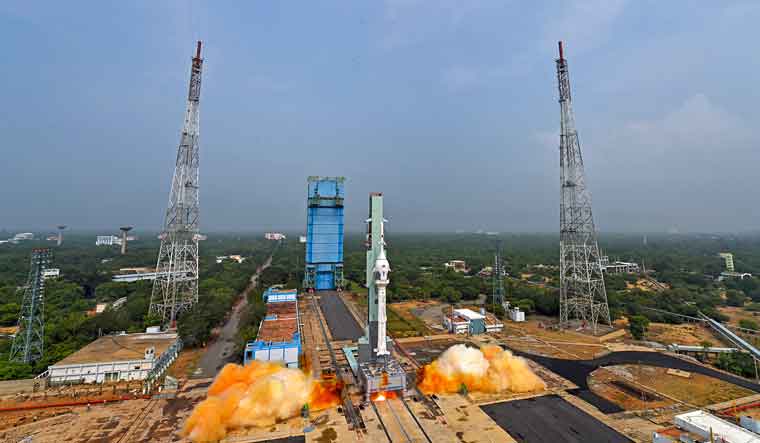With the Aditya-L1 mission successfully reaching the Lagrange point, or L1, at 4 pm IST on Saturday, all eyes are once again on ISRO which has already successfully completed two missions, including the XpoSat, in the first week of January.
On January 1, ISRO Chairman S. Somnath designated 2024 as the "Gaganyaan Year". The space agency has already lined up a series of tests to ensure the mission's success, including the safe return of the astronauts back to earth. However, ISRO's final Gaganyaan trip wherein three astronauts will be sent to to space is not expected to take place until 2025.
ISRO has at least 12 missions slated for the year. During an interview with reporters last week, Chairman S. Somnath said that these missions will comprise India's first human space journey, the Gaganyaan mission, which will carry the three astronauts to an elevation of 400 kilometers above the surface of the earth. He added that the number of launches could go over 12, depending upon ISRO's ability to produce hardware and complete testing.
XPoSat
ISRO silently launched the XPoSat on board the Polar Satellite Launch Vehicle, PSLV-C58, into an extremely low-inclination orbit on January 1. The mission devoted to measuring X-ray polarimetry will study the polarisation of X-rays in the medium frequency range that come from bright celestial sources.
The mission consists of two parts: X-ray spectroscopy and the Indian X-ray Polari meter (POLIX). It is the first device in the world made specifically to function in the medium X-ray timing (8 to 30 keV) energy band. The goal is to perform high spectroscopic resolution and quick timing in the 0.8-15 keV soft X-ray energy region. It is intended for low-earth orbit observation (~ 650 km, ~ 6 degree low inclination). Over the course of its approximately five-year mission, it observes sources that emit polarized X-rays.
ISRO’s Fuel Cell flight
On January 5, ISRO successfully tested a 100W class Polymer Electrolyte Membrane Fuel Cell based Power System (FCPS) in its orbital platform, POEM3, launched onboard PSLV-C58 on January 1. According to ISRO, "The objective of the experiment was to assess Polymer Electrolyte Membrane Fuel cell operation in space and to collect data to facilitate the design of systems for future missions. During the short duration test onboard POEM, 180 W power was generated from Hydrogen and Oxygen gases stored on onboard in high pressure vessels. It provided a wealth of data on performance of various static and dynamic systems that formed part of the power system and the physics at play."
NISAR
NASA-ISRO SAR (NISAR) mission will map the entire planet and the information gathered will be helpful in the understanding the changes happening in earth's ecological systems, glacier mass, flora, elevation of sea levels, groundwater as well as natural disasters like earthquakes, tsunamis, volcanoes, and landslides.
INSAT-3DS
INSAT-3DS is a planned Indian meteorological satellite that will be launched in January 2024. It is carried into the orbit by the GSLV Mk II and it helps considerably to monitor and forecast weather. INSAT-3D is a multifunctional geosynchronous spacecraft equipped with meteorological payloads that will aid in weather forecasting and environmental monitoring
Since antennae on earth will maintain a fixed link with the satellite, the spacecraft's stationary position will allow for continuous communication. This will also help improve the storm warning system.
Mangalyaan-2 (MOM-2)
The Mars Orbiter Mission (Mangalyaan 2) with an improved payload aims to improve the advancement of science. It will utilise aero-braking to change its orbit for the most accurate scientific observation of Mars.
The spacecraft will also have a magnetometer to analyse the Martian magnetic field and radar to image the planet's surface. Mars Orbit Dust Experiment (MODEX), a Radio Occultation (RO) experiment, an Energetic Ion Spectrometer (EIS) and a Langmuir Probe and Electric Field Experiment (LPEX) will be among the payloads aboard the mission.
This mission will study the barren landscape of Mars, interplanetary dust, the environment and the Martian atmosphere.
Shukrayaan-1
Shukrayaan-1 or the Venus Orbiter Mission is India's first attempt to research what lies beneath the neighbouring planet's surface. The project will investigate the planet's sulfuric acid clouds, which have been under intensive examination in recent years. The mission will also investigate the planet's geological and volcanic processes, as well as additional distinctive characteristics. Shukrayaan-1, which is scheduled to be launched in 2024, is expected to orbit Venus for five years after it reaches its destination.
ESA's Proba-3
ISRO will launch the Proba-3 mission by European Space Agency (ESA) that consists of two small satellites that will be launched together. They will separate apart to fly in tandem, to prepare for future multi-satellite missions flying as one virtual structure. Proba-3 aims to mimic an artificial eclipse in space by acting as a mini-Moon and casting an accurate shadow onto the coronagraph
Other missions are also included on the waiting list. With such a wide and impressive schedule, 2024 looks like to be an important turning point for India's space programme.



